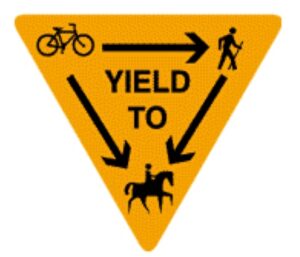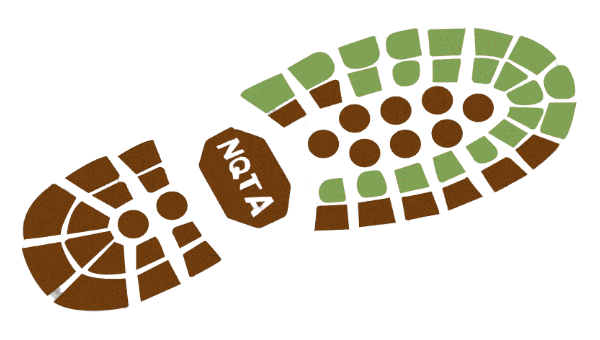 NQTA with the leaders of the Barre Riding and Driving Club, Bay State Trail Riders Association, Friends of the Ware River Watershed, and New England Mountain Bike Association produced a set of guidelines for good trail etiquette. These are also available in a PDF brochure.
NQTA with the leaders of the Barre Riding and Driving Club, Bay State Trail Riders Association, Friends of the Ware River Watershed, and New England Mountain Bike Association produced a set of guidelines for good trail etiquette. These are also available in a PDF brochure.
Tips for Trails
On multi-use trails:
- Bikers yield to Hikers and Horses
- Hikers yield to Horses
- Horses have the natural right of way
It is all trail users’ responsibility to insure that our use of the trails does not spoil that of other trail users, or spoil the trails themselves. The actions of a few individuals often speak for a whole group. We ALL must engage in a public relations and education effort to counter and eliminate any negative image which can cause any trail user to be excluded from using public lands. It is quite possible to have fun and be responsible at the same time (without much effort!). Remember that the future of the use of trails is in YOUR hands.
The Golden Rule
Observer common sense and simple courtesy
- Downhill traffic should yield to uphill traffic.
- When approaching another user, let them know you are there well in advance.
- Communicate – greet other trail users. Horses need to recognize that you are human.
- When meeting horses, Stop, Step off Trail, allow horse & rider to see you and decide who will pass first. At all times remain visible – do not hide be- hind trees or bushes where you cannot be seen.
- Go slow around blind corners.
- If wearing headphones keep the volume down or only wear one earpiece
- Dogs must be on a leash or under verbal command, unless restricted under existing trail regulations.
- When meeting horses, dog owners must first yield the trail to the horse and rider but also make sure their dog stays calm, does not bark and makes no move toward the horse.
- Horse riders & bikers let other users know if you are in a group and how many more riders are behind you. The last user should announce same.
- Take note that the last horse may be the less-experienced or problem horse or less-experienced rider – give them more space. When frightened a horse may kick out.
Tips for Hikers
You are the boots on the ground. Simply step off the trail when encountering other trail users and listen for any directions from them.
Your dog is your responsibility. Please have the dog step off the trail with you and lay down in a non-aggressive posture. Dogs must be on a leash or under verbal command, unless restricted under existing trail regulations.
When hiking alone or in a group, be aware of your trail and surroundings, keep your headsets at a reasonable volume or wear one earpiece.
When encountering a horse: Stop, communicate with the rider, and step off the trail but remain visible to the horse and rider. Always announce your presence as soon as possible to avoid surprising the horse.
Be nice, when encountering other trail users this is a great opportunity to meet and get to know others who enjoy our great outdoors.
Bob Curley, President
North Quabbin Trails Association
nqta.org
Tips for Bikers
Most conflicts with other trail users are caused by differences in speed, surprise or lack of communication. Slowing to the speed of other trail users should be your first response.
When encountering a horse: stop, dismount and communicate with the rider. Always announce your presence as soon as possible to avoid surprising the horse.
While some trails are signed differently, the general rule is that bikers yield to all other trail users. In practice hikers often step aside but you should be ready to stop.
Remain aware of your surroundings by keeping your headsets at a reasonable volume or by wearing one earpiece.
On a hill if possible move to the downhill side as a horse will find you less threatening. If this is not possible then you should ask the rider what would be best.
Most of all be courteous to other trail users. We all have the same objective.
Brett Russ, President
Wachusett NEMBA
nemba.org
Tips for Horseback Riders
Desensitize your horse to encounters you may find on the trail.
Use the buddy system. Its always a good idea to ride with a buddy in case of an emergency.
Get off your high horse. If your horse is panicking and the other trail user is unresponsive when you ask them to slow down or stop, just dismount and wait for them to pass.
Communicate. Greet the other trail user. By engaging in conversation it will help your horse to know the user is a human and not a predator.
Educate other trail users. Assume all other trail users are unfamiliar with horse behavior.
Let other trail users know if you are in a group and how many more riders are behind you. The last rider should announce same.
Most of all be courteous to other trail users. We all have the same objective.
Lynne Goodnow, President
Barre Riding and Driving Club
barreridingdrivingclub.com
Becky Kalagher, President
Bay State Trail Riders Association
bstra.org
